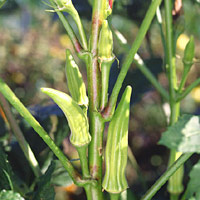Okra

A member of the hibiscus family, okra has one of the most beautiful blooms in the vegetable garden. Okra is used as a natural thickener for soups and stews and is an essential ingredient in gumbo.
About This Plant
Okra is considered a "southern" crop because it thrive in hot weather. However, okra can be grown anywhere, although it bears most abundantly in regions with long, hot summers. Okra is often stewed with tomatoes, deep fried, pickled, boiled or steamed and served with butter, as well as eaten raw, fresh from the garden. Some folks don't like okra's gummy quality when it's boiled or steamed, and it seems to be more popular when combined with other vegetables, fried or pickled.
Site Selection
Select a site with full sun, preferably on a southern slope for maximum warmth, and well-drained soil. Prepare the garden bed by using a garden fork or tiller to loosen the soil to a depth of 12 to 15 inches, then mix in a 2- to 4-inch layer of compost.
Harvesting
The first pods will be ready in 50 to 60 days. Harvest the pods when still immature (2 to 3 inches long). Pick at least every other day to encourage production. Wear gloves and long sleeves to avoid coming in contact with the irritating spines on the leaves and pods. Use a knife to cut the stem just above the cap.
Planting Instructions
In warm regions, plant okra directly in the garden when the nights stay above 55 degrees F and the soil has warmed to 65 degrees F to 70 degrees F. In northern areas, start seeds indoors in peat pots several weeks before the soil warms up. Or direct seed through black plastic and cover the rows with plastic tunnels to hold in the heat. To hasten germination, soak seeds overnight in tepid water or freeze them to crack their coats. Sow seeds 1/2 to 1 inch deep, 3 to 4 inches apart. Set out transplants to stand 1 to 2 feet apart in rows 3 to 4 feet apart.
Care
When the seedlings are about 3 inches tall, thin to stand 1 to 2 feet apart. Provide at least 1 inch of water per week; more in hot, arid regions. When plants are young, cultivate lightly to eliminate weeds. Mulch heavily (4 to 8 inches) to keep weeds down and conserve moisture. Side-dress plants with rich compost. Side-dress three times: after thinning, when the first pods begin to develop, and at least once midway through the growing season. Contact your local County Extension office for controls of common okra pests such as flea beetles.






 A member of the hibiscus family, okra has one of the most beautiful blooms in the vegetable garden. Okra is used as a natural thickener for soups and stews and is an essential ingredient in gumbo.
A member of the hibiscus family, okra has one of the most beautiful blooms in the vegetable garden. Okra is used as a natural thickener for soups and stews and is an essential ingredient in gumbo.